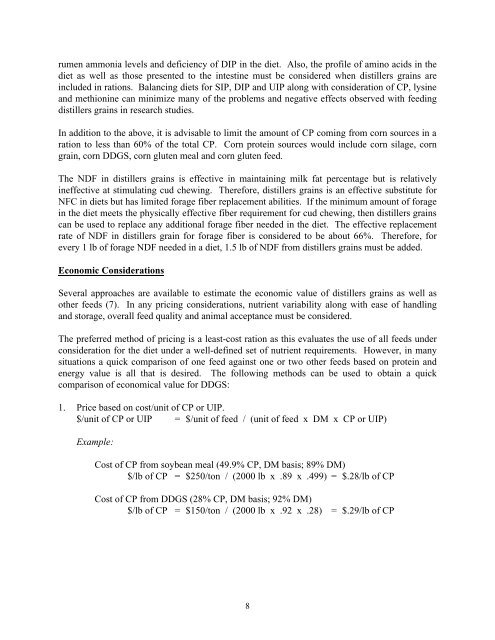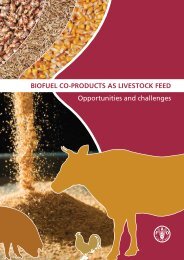Distillers Grains Feeding Recommendations. - Distillers Grains By ...
Distillers Grains Feeding Recommendations. - Distillers Grains By ...
Distillers Grains Feeding Recommendations. - Distillers Grains By ...
You also want an ePaper? Increase the reach of your titles
YUMPU automatically turns print PDFs into web optimized ePapers that Google loves.
umen ammonia levels and deficiency of DIP in the diet. Also, the profile of amino acids in thediet as well as those presented to the intestine must be considered when distillers grains areincluded in rations. Balancing diets for SIP, DIP and UIP along with consideration of CP, lysineand methionine can minimize many of the problems and negative effects observed with feedingdistillers grains in research studies.In addition to the above, it is advisable to limit the amount of CP coming from corn sources in aration to less than 60% of the total CP. Corn protein sources would include corn silage, corngrain, corn DDGS, corn gluten meal and corn gluten feed.The NDF in distillers grains is effective in maintaining milk fat percentage but is relativelyineffective at stimulating cud chewing. Therefore, distillers grains is an effective substitute forNFC in diets but has limited forage fiber replacement abilities. If the minimum amount of foragein the diet meets the physically effective fiber requirement for cud chewing, then distillers grainscan be used to replace any additional forage fiber needed in the diet. The effective replacementrate of NDF in distillers grain for forage fiber is considered to be about 66%. Therefore, forevery 1 lb of forage NDF needed in a diet, 1.5 lb of NDF from distillers grains must be added.Economic ConsiderationsSeveral approaches are available to estimate the economic value of distillers grains as well asother feeds (7). In any pricing considerations, nutrient variability along with ease of handlingand storage, overall feed quality and animal acceptance must be considered.The preferred method of pricing is a least-cost ration as this evaluates the use of all feeds underconsideration for the diet under a well-defined set of nutrient requirements. However, in manysituations a quick comparison of one feed against one or two other feeds based on protein andenergy value is all that is desired. The following methods can be used to obtain a quickcomparison of economical value for DDGS:1. Price based on cost/unit of CP or UIP.$/unit of CP or UIP = $/unit of feed / (unit of feed x DM x CP or UIP)Example:Cost of CP from soybean meal (49.9% CP, DM basis; 89% DM)$/lb of CP = $250/ton / (2000 lb x .89 x .499) = $.28/lb of CPCost of CP from DDGS (28% CP, DM basis; 92% DM)$/lb of CP = $150/ton / (2000 lb x .92 x .28) = $.29/lb of CP8
















